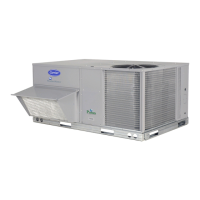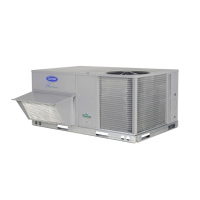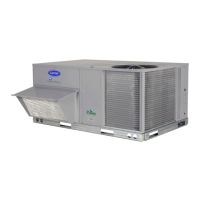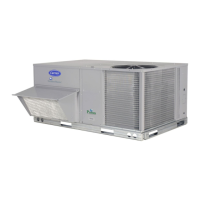Step 5 — Select and Install Ductwork — The de-
sign and installation of the duct system must be in accor-
dance with the standards of the NFPA (National Fire Protec-
tion Association) for installation of nonresidence-type air
conditioning and ventilating systems, NFPA90Aor residence-
type, NFPA90B; and/or local codes and residence-type, NFPA
90B; and/or local codes and ordinances.
Select and size ductwork, supply-air registers and
return-air grilles according to ASHRAE (American Society
of Heating, Refrigeration, and Air Conditioning Engineers)
recommendations.
The unit has duct flanges on the supply- and return-air
openings on the side of the unit. See Fig. 2-5 for connection
sizes and locations.
When designing and installing ductwork, consider the
following:
When connecting ductwork to units, do not drill deeper
than
1
⁄
2
inch in shaded area in Fig. 10 or coil may be
damaged.
• All units should have field-supplied filters or accessory fil-
ter rack installed in the return-air side of the unit. Rec-
ommended sizes for filters are shown in Table 1.
• Avoid abrupt duct size increases and reductions. Abrupt
change in duct size adversely affects air performance.
IMPORTANT: Use flexible connectors between
ductwork and unit to prevent transmission of vibra-
tion. Use suitable gaskets to ensure weathertight and
airtight seal. When electric heat is installed, use fire-
proof canvas (or similar heat resistant material) con-
nector between ductwork and unit discharge connec-
tion. If flexible duct is used, insert a sheet metal sleeve
inside duct. Heat resistant duct connector (or sheet metal
sleeve) must extend 24-in. from electric heater
element.
• Size ductwork for cooling air quantity (cfm). The mini-
mum air quantity for proper electric heater operation is
listed in Table 2. Heater limit switches may trip at air quan-
tities below those recommended.
• Insulate and weatherproof all external ductwork. Insulate
and cover with a vapor barrier all ductwork passing through
conditioned spaces. Follow latest Sheet Metal andAir Con-
ditioning Contractors NationalAssociation (SMACNA) and
Air Conditioning Contractors Association (ACCA) mini-
mum installation standards for residential heating and air
conditioning systems.
• Secure all ducts to building structure. Flash, weather-
proof, and vibration-isolate duct openings in wall or roof
according to good construction practices.
Figure 11 shows a typical duct system with 50HS
installed.
Table 2 — Minimum Airflow for
Safe Electric Heater Operation
SIZE 018 024 030 036 042 048 060
CFM 700 700 875 1200 1225 1400 1750
NOTE: Do not drill more than
1
⁄
2
-in. deep into shaded area.
Fig. 10 — Area Not To Be Drilled
Power Wiring
Control Wiring
Outdoor Airflow
Indoor Airflow
*Separate disconnect per NEC
(National Electric Code) required
for electric heater when single-
point connection is not used.
Fig. 11 — Typical Installation
10

